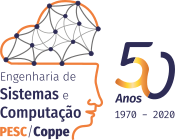Multitarget Tracking System with Connectivity Constraints
Autores
|
5938 |
2734,131
|
|
|
5939 |
2734,131
|
Informações:
Publicações do PESC
Título
Multitarget Tracking System with Connectivity Constraints
Linha de pesquisa
Inteligência Artificial
Tipo de publicação
Tese de Doutorado
Número de registro
Data da defesa
30/3/2016
Resumo
A primeira parte deste trabalho lida com o problema de posicionar um grupo de agentes retransmissores (relays) de forma a dar conectividade a um segundo grupo de agentes ativos (pursuers). A primeira abordagem apresentada consiste em modelar o cenário como um problema de programação quadrática (PPQ) com restrições lineares, usando uma estrutura de conectividade fixa. Para resolver o modelo proposto, foi implementada uma rede neural recorrente a qual converge rapidamente para a solução ótima do problema, mesmo em instâncias razoavelmente grandes. Como forma de avaliação, realizou-se um comparativo entre o solver de PPQ da plataforma Matlab e a rede proposta, também implementada na mesma plataforma. Na segunda abordagem foi proposto o uso de uma estimativa da conectividade algébrica do grafo de proximidade gerado pela rede, para direcionar o grupo de relays e pursuers, usando-se apenas as informações da vizinhança de cada agente. Nesta abordagem a estrutura do grafo é dinâmica, além disso, como proposta de paralelização, a esta solução distribuída foi acoplada um algoritmo de escalonamento por reversão de arestas (SER). Além do mais, as metaheurísticas Simulated Annealing, Genetic Algorithms, Particle Swarm Optimization e Backtracking Search Algorithm foram implementadas como alternativas de soluções ao problema. As soluções são avaliadas em um cenário de perseguição de alvos, os quais podem possuir comportamentos reativos (tais como fugir dos perseguidores). A segunda parte deste trabalho investiga o problema de rastreamento de múltiplos objetos em tempo real. Como solução, foi proposto um algoritmo que se baseia em memória de curto e longo prazo usando redes neurais sem peso.
Abstract
The first part of this work deals with the problem of positioning a swarm of relay agents with the objective of providing connectivity to a second group of active agents (pursuers). The first approach consists of modelling the considered scenario as a quadratic programming problem (QP) with linear restrictions, using a fixed graph structure. In order to solve such model, a recurrent neural network is proposed with fast convergence rate to the optimal solution, even with reasonably big size instances. In addition, a comparison with the Matlab QP solver has been conducted in some experimental simulations. In the second approach, it is proposed an estimation of the algebraic connectivity of the underlying graph generated by the network. Over this estimation, it is proposed a metric to direct the group of relays and pursuers, using only local neighbourhood information of each agent. On this approach, the graph structure is dynamic and it is also proposed the use of the schedule by edge reversal (SER) as a solution to ordering the parallelization of the robot positioning computation. Moreover, the meta-heuristics Simulated Annealing, Genetic Algorithms, Particle Swarm Optimization and Backtracking Search Algorithm have been applied as alternative solution providers. The proposed solutions have been applied in a target pursuit scenario, for which the targets are deployed in different spots and may have some reactive behaviours (such as escape from the pursuers).The second part of this work investigates the visual tracking of shape shift objects in real time. As a solution, it is proposed a short- and long-time memories tracker which uses a weightless neural network for training and retraining the objects patterns.
Arquivo




